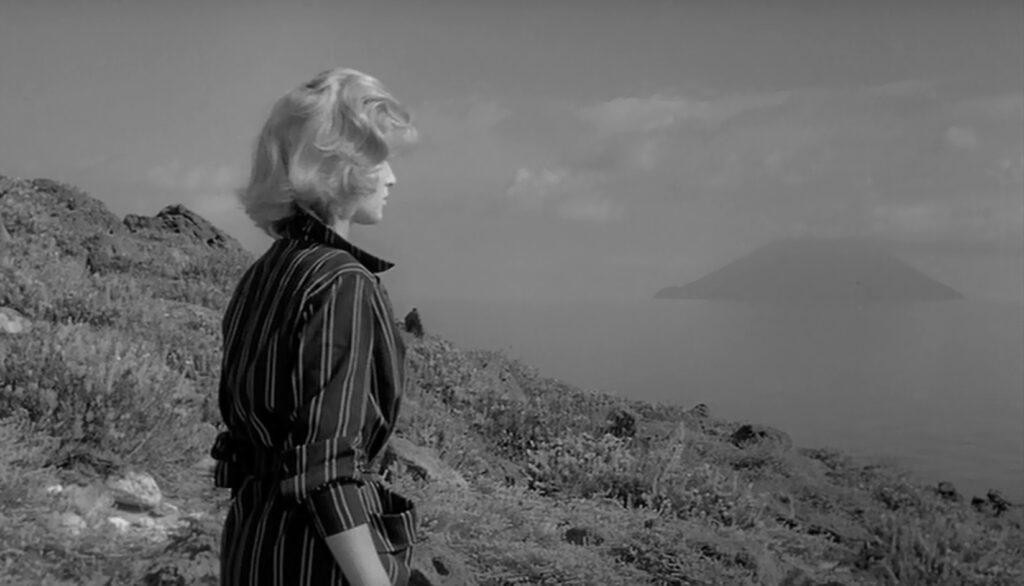
L’avventura
1960, directed by Michelangelo Antonioni
The great mystery of L’avventura is the disappearance of Anna… not her disappearance from the Aeolian island of Lisca Bianca, which the movie gradually leaves behind, but her second unexplained disappearance in the movie’s second half. After vanishing physically she vanishes again from the hearts and minds of the people closest to her, her lover and her best friend. Sandro and Claudia are well aware of this, and they express amazement that it could happen so fast. Audiences may find this second disappearance mundane in comparison to what happened on the island, but it’s certainly not mundane to the people who have to live with it. How can our deepest human bonds, for which we would readily alter our lives, be so ephemeral that they’re practically forgotten within two or three days?
For that matter the same thing happens between Sandro and Claudia. At the peak of their new love affair, only a day after proposing marriage, Sandro momentarily forgets Claudia and gives in to temptation with Gloria Perkins, the foreign woman who had courted scandal in Messina. In many ways L’avventura returns to Kyoko’s question in Tokyo Story: “Isn’t life disappointing?” – and like Ozu’s film it examines the question with a spirit of wonder.
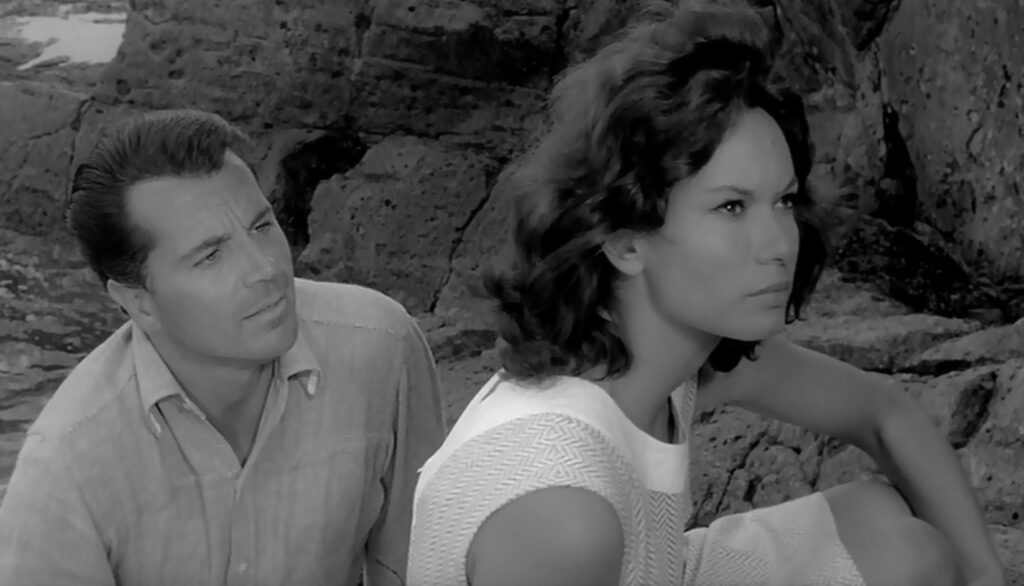
L’avventura made a sensational impression when it came out, drawing first catcalls then high praise at the Cannes Film Festival, then two years later taking second place in the Sight & Sound critics’ poll, unheard of for a new film. Its novelty has faded with time, likely because so many filmmakers learned from Antonioni how to slow time down to the pace of real life. Until 1960 almost every narrative film was edited with an economy of time, cutting each shot to the exact length needed to move the story forward and develop characters. Suddenly a movie comes along that lingers over landscapes and extraneous details. Characters walk without purpose or show their boredom. Watching L’avventura felt, for better or worse, almost like living it.
As we know today all too well, anyone can slow down the pace of a movie. What’s less obvious about Antonioni’s method, here and in other films, is the way he dampens the drama without sacrificing the richness of incident. Most movies push their stories to emotional extremes to maintain audience interest, but Antonioni never hesitates to waste the dramatic potential in a scene. Whenever the story threatens to turn dramatic, whether it’s a shark in the water, a fight about to start, a marriage proposal, or a crowd of men ogling a woman, the dramatic expectation is always thwarted. Even in small ways the film avoids drama. Characters never overreact with melodramatic offense or self-pity: “I love you.” “Tell me again.” “I don’t love you.” “I deserve that.” All these deflections of drama make the movie more authentic. In real life most situations don’t erupt as if to draw maximum attention, except insofar as movies and television have taught people to react to each other melodramatically.
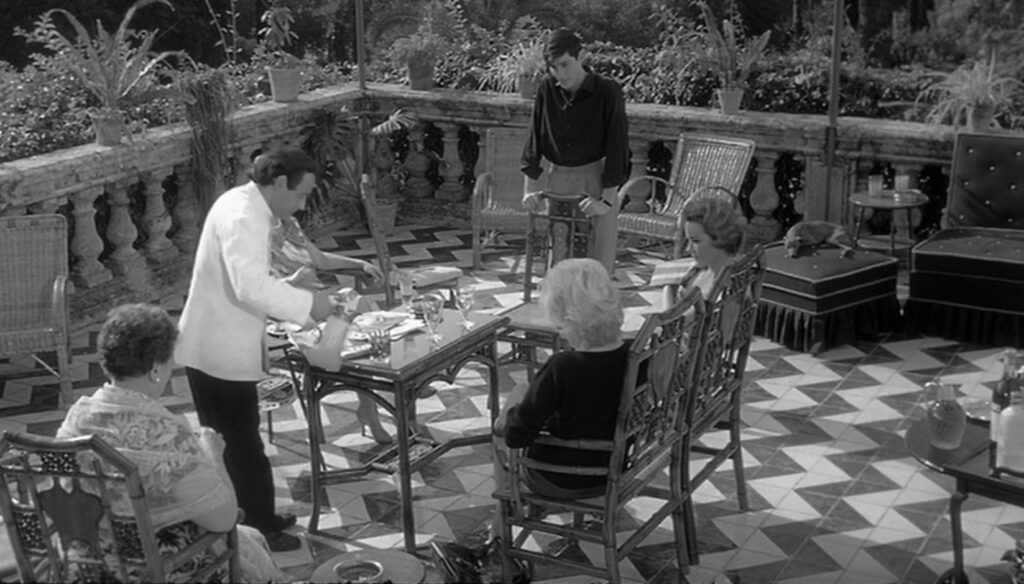
More than making L’avventura true to life, the lack of drama opens space, in the viewer’s experience, for wonder. When we watch a western that’s set in Monument Valley, the excitement of the chase or the gun battle distracts us from the wonder of the landscape, which becomes a faint echo of the drama. When Anna’s friends climb over Lisca Bianca searching for her, we have time to marvel at the tornado over the sea or the hazy outlines of faraway islands which convey such a vast sense of space. It’s relatively easy to feel wonder at the Aeolian landscape, but it prepares us to make room for a less obvious sense of wonder at the more ordinary details in the second half, including the strange vicissitudes of emotional life, like the way Anna fades from her friends’ consciousness.
Taking advantage of its Mediterranean setting, L’avventura evokes a sense of wonder also at the vastness of history, evoking past centuries in the architecture, paintings, Corrado’s talk of ruins on the island, the antique vase, and Giovanni Fusco’s score which deliberately blends a jazzy modern spirit with a flavor of ancient Greece. The characters’ names likewise point to the ancient world: Claudia (the Claudian dynasty), Sandro (Alexander the Great), Patrizia (Roman patricians), Giulia (Julius Caesar), and Ettore (Hector).
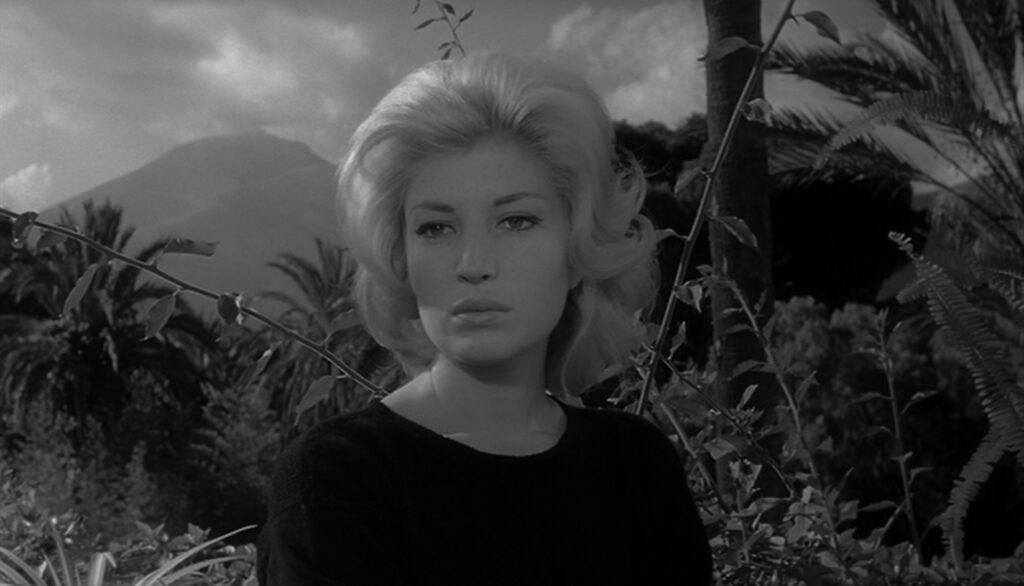
The point of L’avventura is not to maximize a sensation of awe in the same way that drama maximizes excitement. The phenomenon of wonder, rather, is synonymous with a sharpness of vision. Genuine and lasting wonder happens not when we imagine some ideal or extreme world, but when we see the world as it’s given to us – even the mundane and disappointing. Antonioni’s chief purpose, at least from L’avventura forward, is to intensify our vision, to teach us to apprehend the world and our own lives from a perspective that transcends our petulant desires to make things the way we want them to be. Our habit of molding the world to our wishes, not only in our work but in our vision, is what makes disappointment so unbearable. There’s also, in Antonioni’s method, a lesson in watching movies. Most people come to a movie expecting steady stimulation, a rising dramatic trajectory, characters they can identify with, and a satisfying resolution. L’avventura refuses these demands, hoping to teach us to see a movie for what it is, not what we want it to be.
In place of a mounting dramatic arc with closure at the end, L’avventura brings us back where we started, this time with a clearer and more mature vision. The opening scene, like the ending, is a picture of disappointment. Anna’s father is disappointed with the housing development happening around his villa; the father and daughter are disappointed in each other; the father is disappointed in his diplomatic career, and he’s disappointed in Sandro. What’s unusual, in retrospect, is that none of this goes anywhere dramatically. We’re simply left to take note of it and move on, ultimately to find it resonating at the end in Taormina. The two scenes resonate in another way: the opening is set to the west of the Vatican hill, and the dome of St. Peter’s Basilica rises conspicuously in the background; while at the end, Mount Etna fills the place of St. Peter’s. One landmark echoes another, but the second one, significantly, is a landmark of nature without the moralistic and emotional connotations that the Vatican carries, especially for Italians. We can more easily look at a mountain for what it really is.
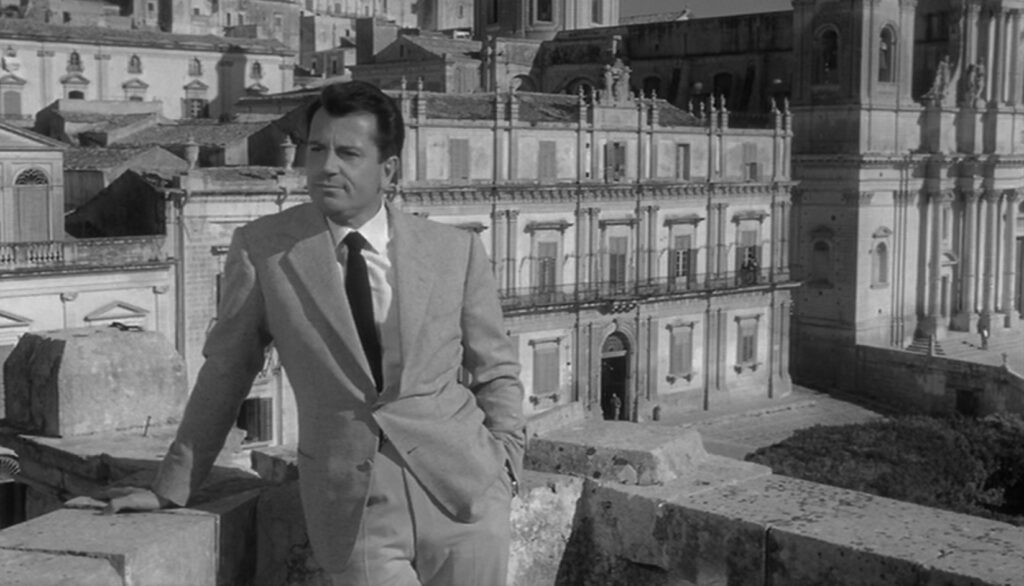
The idea of a journey that returns to its beginning implies a round trip, a kind of palindrome. It’s not obvious that L’avventura forms a palindrome until we realize how many ways its second half echoes its first. Sandro tosses newspaper pages off the boat, and electioneers in Noto toss flyers out of a car. Sandro discusses marriage with Anna on the island overlooking the sea, and he proposes to Claudia on a church roof overlooking a city. A throng of excited men swarms around Gloria Perkins in Messina, and another crowd gathers around Claudia in Noto. Anna asks “Why, why, why, why, why, why?” in Rome, and Sandro asks “Why, why, why?” on the bell tower. The search party on Lisca Bianca uses suspension ropes which look like the bell ropes in Noto. Sandro picks a fight with a fisherman and again with an architecture student. Anna lies about a shark, and Sandro lies about the spilt ink. Claudia spies Sandro making love to Anna in Rome and catches him with Gloria Perkins at the end. These and many other echoes help the viewer to look at ordinary details with the interest normally reserved for the dramatic.
The title of L’avventura refers outwardly to the characters’ journey, with a further connotation in Italian of a romantic or sexual fling, as Sandro jokingly calls his affair with Claudia. More importantly though, the title describes the movie’s intention to offer an experience instead of a story. This difference between story and experience accounts for the gap between audience expectation and the reality of L’avventura. A story is supposed to be dramatic, and it puts the listener or viewer in a passive position, but an experience implies active participation, and in the end it should be more memorable. Most movies pretend to offer an experience, but it’s only a vicarious version of what the characters go through. If we watch L’avventura attentively, our experience will be something apart from Sandro’s and Claudia’s experience.
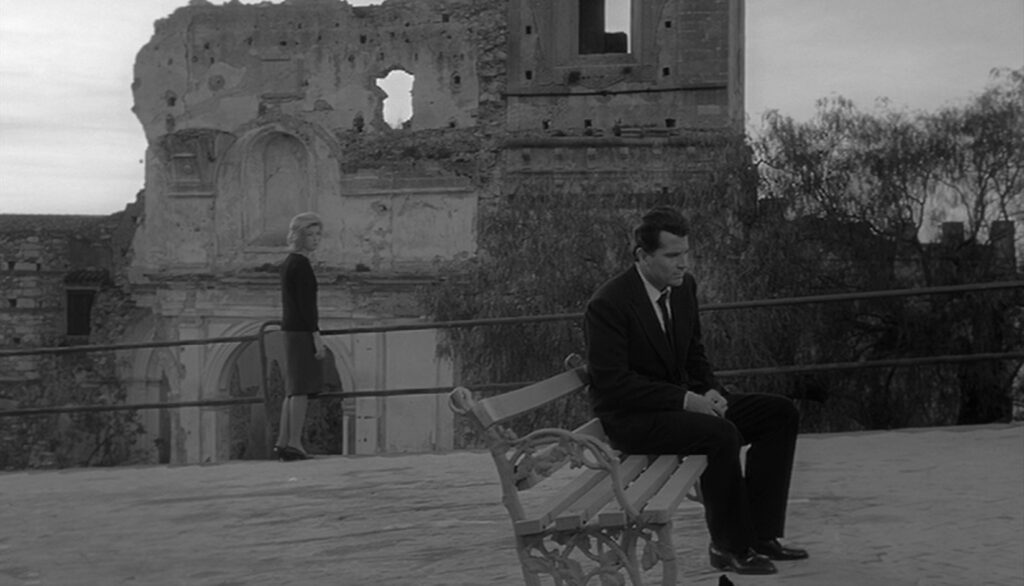
At the end, Sandro has just betrayed Claudia with another woman, but the movie shows no effort to provoke our emotions. Instead of telling us what to think or feel, it allows us to look at the situation in its totality. There is no sentimentality, no outrage, no judgment, nor does the movie end in a way that charts the rest of the characters’ lives together with satisfying clarity. Just as L’avventura never explains Anna’s disappearance from the island, it also never tries to explain why people think and feel and act as they do. We’re left rather to marvel at the ineffable mystery of life, and by doing so we can begin to put our own lives in a larger perspective.
CONNECTIONS:
The Lady Vanishes – A woman disappears more times than the plot seems to indicate
Rome, Open City – Bracketed (in whole or in half) by the dome of St. Peter’s Basilica
The Flavor of Green Tea over Rice – A small wrinkle in time (Mokichi’s return, Sandro boarding the westbound train) smooths things over for a couple
Tokyo Story – Looks at the disappointing nature of life with wonder; minimization of dramatic content; builds to an ineffable feeling at the end
Ordet – Search for a missing character in a wild setting, with a montage of characters calling the missing person’s name
Death of a Cyclist – Palindromic structure; similarity between crowds at Juan’s college and Messina
Night Train – Frenzied crowds; de-escalation of the dramatic
Plein soleil – Yacht trip in Tyrrhenian Sea; echoing incidents; mise-en-scène tied to drama
The Birds – Menacing accumulation of men/birds in a single location across a short time (men in Noto, crows in playgound)
2 or 3 Things I Know About Her – Palindromic structure; wonder achieved through a shift in vision
Whity – Action slowed down to drain it of dramatics and enhance the audience’s vision
Nathalie Granger – Rhymes or echoes serve as a pathway to seeing the material more closely
The Day He Arrives – Finding wonder in the outwardly disappointing nature of reality
Arrival – Palindrome as aid to vision; Anna/Hannah
LIST OF ECHOES BETWEEN THE 1ST AND 2ND HALVES OF L’AVVENTURA
(in order of occurrence in the first half)
- Dome of San Pietro – Mount Etna
- Nuns walking by the Tiber – priests and altar boys in Noto (also dressed in black)
- Claudia spies Sandro making love to Anna – again with Gloria Perkins
- Anna asks “Why, why, why, why, why, why?” – Sandro asks “Why, why, why?”
- Gallery by Sandro’s apartment – hotel in Taormina filled with art
- Tossing newspaper into the sea – throwing campaign flyers into the street of Noto
- Lie about the shark (interfering with fun) – lie about the inkwell (interfering with work)
- Anna gives Claudia her shirt – Claudia embraces Sandro’s shirt
- Marriage talk with Anna (above sea, sound of waves) – proposal to Claudia (above city, bells)
- Anna disappears from Lisca Bianca – Anna vanishes from the consciousness of her loved ones
- Calling for Anna on the island – Claudia calls out to find out whether town is empty
- Sandro picks fight with fisherman – again with architecture student
- Suspension ropes during the search – bell ropes on the church roof in Noto
- Raimondo drops ancient vase on Lisca Bianca – Claudia drops suitcase at Hotel San Domenico
- Train to Palermo – train passing Sandro and Claudia as they kiss
- Men swarming around Gloria Perkins in Messina – men gathering around Claudia in Noto